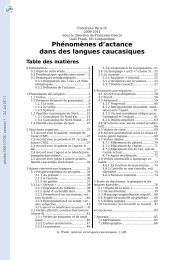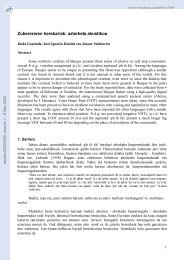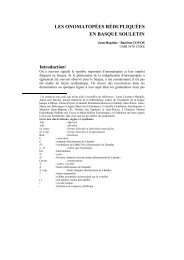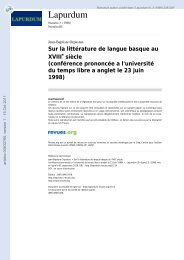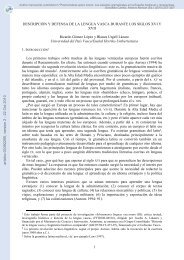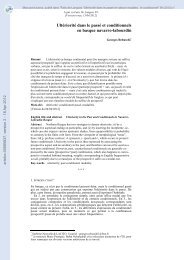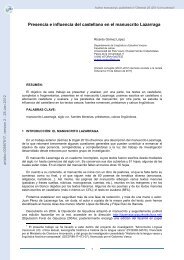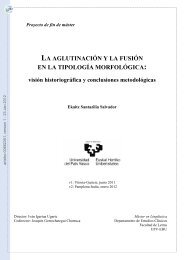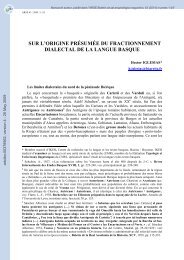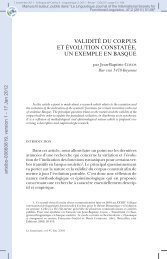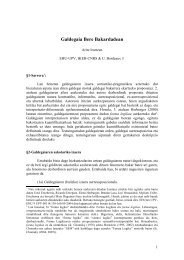On the polysemy of the suffike-ke in the history of Northern Basque
On the polysemy of the suffike-ke in the history of Northern Basque
On the polysemy of the suffike-ke in the history of Northern Basque
Create successful ePaper yourself
Turn your PDF publications into a flip-book with our unique Google optimized e-Paper software.
artxibo-00494270, version 1 - 22 Jun 2010<br />
472 GEORGES REBUSCHI<br />
c Ezk (1974: N-L) - Bertzela sarririk ez du<strong>ke</strong>zue zuen Aita zerukoaren a<strong>in</strong>tz<strong>in</strong>ean.<br />
30<br />
Here are now examples with two unaccusative verbs.<br />
(12) Imit 3,48,9 - Ipsi stabunt foris ejulantes. ‘They will stay out lament<strong>in</strong>g.’<br />
Léon (1929: B-N) 31 Kanpoan baitagoz<strong>ke</strong> hek orrobiaka.<br />
(13) Mt 6,23<br />
LV - Si autem oculus tuus nequam fuerit, totum corpus tuum tenebrosum erit.<br />
Si ergo lumen, quod <strong>in</strong> te est, tenebrae sunt, tenebrae quantae erunt!<br />
CDR - ‘But if thy eye be evil thy whole body shall be darksome. If <strong>the</strong>n <strong>the</strong><br />
light that is <strong>in</strong> <strong>the</strong>e, be darkness: <strong>the</strong> darkness itself how great shall it be!’<br />
a Lç (1571) 32 - Ba<strong>in</strong>a bald<strong>in</strong> hire begia gaixto bada hire gorputz guzia ilhun<br />
da.te.k: beraz bald<strong>in</strong> hitan den argia ilhunbe bada, ilhunbe hura ze<strong>in</strong> handi<br />
date? 33<br />
b Dv (1859-65: Lab.) - Aitzitik zure begia gaitza badaite, beltza daite zure gorphutz<br />
guzia. Bald<strong>in</strong> beraz zure baithan den argia ilhunbea [ba]daite, ilhunbeak<br />
berak zenbatekoak ez daizte? 34<br />
c Léon (1946: B-N) - eri bal<strong>in</strong> baduzu aldiz begia, ilhun du<strong>ke</strong>zu35 gorputz<br />
guzia. Zutan den argia ilhunbe bal<strong>in</strong> bada beraz, nolakoak ditaz<strong>ke</strong> ilhunbeak<br />
berak?<br />
30 I have even found examples <strong>in</strong> which only Léon (first half <strong>of</strong> <strong>the</strong> 20th century) uses -<strong>ke</strong> with a future<br />
value, e.g.:<br />
(a) Mk 16,(17-)18<br />
LV-17: signa autem eos qui credider<strong>in</strong>t haec sequentur… 18: serpentes tollent et si mortiferum<br />
quid biber<strong>in</strong>t non eos nocebit super aegrotos manus <strong>in</strong>ponent et bene habebunt / KJV - 17: And<br />
<strong>the</strong>se signs shall follow <strong>the</strong>m that believe… 18: They shall ta<strong>ke</strong> up serpents; and if <strong>the</strong>y dr<strong>in</strong>k<br />
any deadly th<strong>in</strong>g, it shall not hurt <strong>the</strong>m; <strong>the</strong>y shall lay hands on <strong>the</strong> sick, and <strong>the</strong>y shall recover.<br />
Léon (1946)-17: S<strong>in</strong>esten dutenek huna zer mirakuluak eg<strong>in</strong>en dituzten: … 18 sugeak eskuetan<br />
erabiliko, eta phozo<strong>in</strong>kia iretsirik ere ez du<strong>ke</strong>te kalterik, eskuak erien ga<strong>in</strong>ean emanen dituzte eta<br />
eriak sendatuko dira. [Lit. «<strong>the</strong>y shall have no harm».]<br />
31 Here aga<strong>in</strong>, all <strong>the</strong> o<strong>the</strong>r translations <strong>in</strong> Nor<strong>the</strong>rn <strong>Basque</strong> I know <strong>of</strong> have an analytic future here,<br />
egonen dire/dira: Pouvreau (1669), Arambillaga (1684), Chourio (1720), Haristoy (1896) <strong>in</strong> <strong>the</strong> Labourd<strong>in</strong><br />
dialect, and Maister (1757) and Inchauspé (1883) <strong>in</strong> Soulet<strong>in</strong>.<br />
32 It is difficult to classify Leiçarraga’s language dialectwise; <strong>the</strong> translation obviously was <strong>in</strong>tended<br />
to help build a Nor<strong>the</strong>rn <strong>Basque</strong> ko<strong>in</strong>è, and displays many Labourd<strong>in</strong> properties. However, as far as <strong>the</strong><br />
conjugation is concerned, it def<strong>in</strong>itely displays many eastern features - see <strong>the</strong> detailed discussion <strong>in</strong> Lafon<br />
(1944: I, 59-65).<br />
33 Leiçarraga never used <strong>the</strong> familiar or «allocutive» forms (da.te.k here) <strong>in</strong> questions.<br />
34 Note first that <strong>the</strong> «futural» form ba.dai.te is also used <strong>in</strong> <strong>the</strong> two protases here — compare Lafon<br />
([1970] 1999: 497): «Aujourd’hui même, [il] s’emploie rarement. Au lieu de dire badoa<strong>ke</strong> “s’il peut<br />
venir”, har badeza<strong>ke</strong> “s’il peut prendre”, on ajoute plutôt ahal “possible à des suppositifs ord<strong>in</strong>aires”:<br />
Joaiten ahal bada, hartzen ahal badu.»<br />
Second, note that this sentence also illustrates <strong>the</strong> (purely morphological) neutralisation between<br />
<strong>the</strong> izan «be» and °ed<strong>in</strong> <strong>in</strong> some varieties <strong>of</strong> lap and NL (as described <strong>in</strong> Bonaparte (1869) and Lafitte<br />
(1962), between o<strong>the</strong>rs). This is also true <strong>of</strong> <strong>the</strong> plural form daizte at <strong>the</strong> end <strong>of</strong> this example, and <strong>of</strong> ditaz<strong>ke</strong><br />
<strong>in</strong> (10c). But, as shown by ex. (12a) and (c), this was nei<strong>the</strong>r <strong>the</strong> case <strong>in</strong> Leiçarraga’s NT, nor <strong>in</strong><br />
late 19th century Zub.<br />
35 The copula is twice translated by its bivalent variant «have» here.<br />
0 ASJU Oyharcabal.<strong>in</strong>dd 472 21/07/09 12:54



